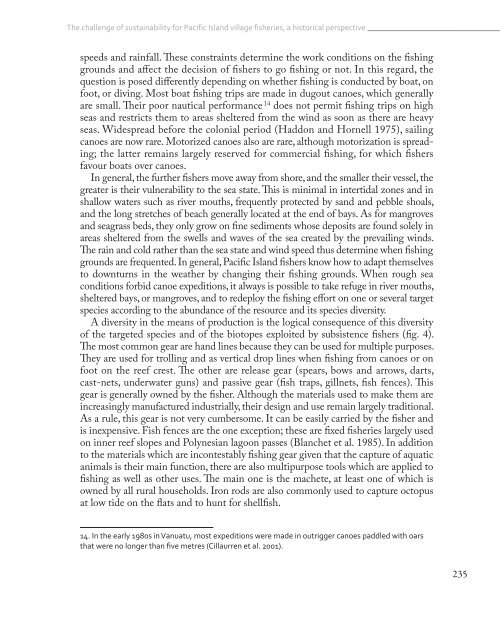Fisheries in the Pacific
Fisheries_in_the_Pacific
Fisheries_in_the_Pacific
Create successful ePaper yourself
Turn your PDF publications into a flip-book with our unique Google optimized e-Paper software.
The challenge of susta<strong>in</strong>ability for <strong>Pacific</strong> Island village fisheries, a historical perspective<br />
speeds and ra<strong>in</strong>fall. These constra<strong>in</strong>ts determ<strong>in</strong>e <strong>the</strong> work conditions on <strong>the</strong> fish<strong>in</strong>g<br />
grounds and affect <strong>the</strong> decision of fishers to go fish<strong>in</strong>g or not. In this regard, <strong>the</strong><br />
question is posed differently depend<strong>in</strong>g on whe<strong>the</strong>r fish<strong>in</strong>g is conducted by boat, on<br />
foot, or div<strong>in</strong>g. Most boat fish<strong>in</strong>g trips are made <strong>in</strong> dugout canoes, which generally<br />
are small. Their poor nautical performance 14 does not permit fish<strong>in</strong>g trips on high<br />
seas and restricts <strong>the</strong>m to areas sheltered from <strong>the</strong> w<strong>in</strong>d as soon as <strong>the</strong>re are heavy<br />
seas. Widespread before <strong>the</strong> colonial period (Haddon and Hornell 1975), sail<strong>in</strong>g<br />
canoes are now rare. Motorized canoes also are rare, although motorization is spread<strong>in</strong>g;<br />
<strong>the</strong> latter rema<strong>in</strong>s largely reserved for commercial fish<strong>in</strong>g, for which fishers<br />
favour boats over canoes.<br />
In general, <strong>the</strong> fur<strong>the</strong>r fishers move away from shore, and <strong>the</strong> smaller <strong>the</strong>ir vessel, <strong>the</strong><br />
greater is <strong>the</strong>ir vulnerability to <strong>the</strong> sea state. This is m<strong>in</strong>imal <strong>in</strong> <strong>in</strong>tertidal zones and <strong>in</strong><br />
shallow waters such as river mouths, frequently protected by sand and pebble shoals,<br />
and <strong>the</strong> long stretches of beach generally located at <strong>the</strong> end of bays. As for mangroves<br />
and seagrass beds, <strong>the</strong>y only grow on f<strong>in</strong>e sediments whose deposits are found solely <strong>in</strong><br />
areas sheltered from <strong>the</strong> swells and waves of <strong>the</strong> sea created by <strong>the</strong> prevail<strong>in</strong>g w<strong>in</strong>ds.<br />
The ra<strong>in</strong> and cold ra<strong>the</strong>r than <strong>the</strong> sea state and w<strong>in</strong>d speed thus determ<strong>in</strong>e when fish<strong>in</strong>g<br />
grounds are frequented. In general, <strong>Pacific</strong> Island fishers know how to adapt <strong>the</strong>mselves<br />
to downturns <strong>in</strong> <strong>the</strong> wea<strong>the</strong>r by chang<strong>in</strong>g <strong>the</strong>ir fish<strong>in</strong>g grounds. When rough sea<br />
conditions forbid canoe expeditions, it always is possible to take refuge <strong>in</strong> river mouths,<br />
sheltered bays, or mangroves, and to redeploy <strong>the</strong> fish<strong>in</strong>g effort on one or several target<br />
species accord<strong>in</strong>g to <strong>the</strong> abundance of <strong>the</strong> resource and its species diversity.<br />
A diversity <strong>in</strong> <strong>the</strong> means of production is <strong>the</strong> logical consequence of this diversity<br />
of <strong>the</strong> targeted species and of <strong>the</strong> biotopes exploited by subsistence fishers (fig. 4).<br />
The most common gear are hand l<strong>in</strong>es because <strong>the</strong>y can be used for multiple purposes.<br />
They are used for troll<strong>in</strong>g and as vertical drop l<strong>in</strong>es when fish<strong>in</strong>g from canoes or on<br />
foot on <strong>the</strong> reef crest. The o<strong>the</strong>r are release gear (spears, bows and arrows, darts,<br />
cast-nets, underwater guns) and passive gear (fish traps, gillnets, fish fences). This<br />
gear is generally owned by <strong>the</strong> fisher. Although <strong>the</strong> materials used to make <strong>the</strong>m are<br />
<strong>in</strong>creas<strong>in</strong>gly manufactured <strong>in</strong>dustrially, <strong>the</strong>ir design and use rema<strong>in</strong> largely traditional.<br />
As a rule, this gear is not very cumbersome. It can be easily carried by <strong>the</strong> fisher and<br />
is <strong>in</strong>expensive. Fish fences are <strong>the</strong> one exception; <strong>the</strong>se are fixed fisheries largely used<br />
on <strong>in</strong>ner reef slopes and Polynesian lagoon passes (Blanchet et al. 1985). In addition<br />
to <strong>the</strong> materials which are <strong>in</strong>contestably fish<strong>in</strong>g gear given that <strong>the</strong> capture of aquatic<br />
animals is <strong>the</strong>ir ma<strong>in</strong> function, <strong>the</strong>re are also multipurpose tools which are applied to<br />
fish<strong>in</strong>g as well as o<strong>the</strong>r uses. The ma<strong>in</strong> one is <strong>the</strong> machete, at least one of which is<br />
owned by all rural households. Iron rods are also commonly used to capture octopus<br />
at low tide on <strong>the</strong> flats and to hunt for shellfish.<br />
14. In <strong>the</strong> early 1980s <strong>in</strong> Vanuatu, most expeditions were made <strong>in</strong> outrigger canoes paddled with oars<br />
that were no longer than five metres (Cillaurren et al. 2001).<br />
235


